4.1 External Major Congenital Anomalies for Monitoring
On this Page
Expected time: 1 hour
When collecting public health surveillance data for congenital anomalies, the quality of the data is as important as the quantity. High-quality data on a smaller number of congenital anomalies will be more useful to public health congenital anomaly surveillance than poor-quality data on all congenital anomalies.
How to Assess a Newborn for Birth Defects
Show “A video guide to a stepwise surface examination of newborns” at http://www.who.int/tdr/publications/videos/completed-productions/en/external icon.
This video shows how to assess a newborn for birth defects. Sometimes, birth defects can be linked to drug exposure during the pregnancy. However, early assessment for birth defects through newborn screening can also show that a treatment need not be contraindicated in pregnancy, because it has no risk for adverse outcomes. This screening can help get life-saving treatments to the mother, child or both. The training for this DVD was carried out by Prof Lewis Holmes, who trained Ghanaian nurse/midwives in a small facility outside Accra. After training, the health workers were filmed carrying out the assessments themselves. This DVD, developed by the World Health Organization through TDR and the Reproductive Health and Research Programme has been successfully used to train other health workers in five countries (four in Africa and one in South America). It supports a new protocol for a pregnancy registry.
Please refer to Chapter 4 in WHO/CDC/ICBDSR Birth defects surveillance: a manual for programme managers (4) for details on selected major congenital anomalies.
Activity 4.1
Ask participants to refer to Activity 4.1 worksheet in the Participant Workbook pdf icon[457 KB, 21 Pages, Print Only].
Have participants view and compare photos of anencephaly, encephalocele and spina bifida, and describe the differences. After enough time has been given to complete the activity, discuss responses aloud as a larger group.
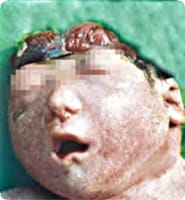
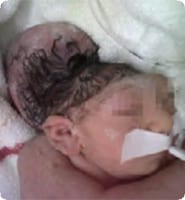
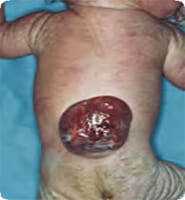
Responses:
- Anencephaly is characterized by either total or partial absence of the brain, together with total or partial absence of the cranial vault and the covering skin.
- An encephalocele is a pedunculated or sessile cystic lesion protruding through a defect in the skull.
- Spina bifida is a general term used to describe a neural tube defect of the spine, in which part of the meninges or spinal cord, or both, protrudes through an opening in the vertebral column.
Have participants identify the diagnoses for each of the following congenital anomalies. After enough time has been given to complete the activity, discuss the differences between gastroschisis and omphalocele aloud as a larger group.
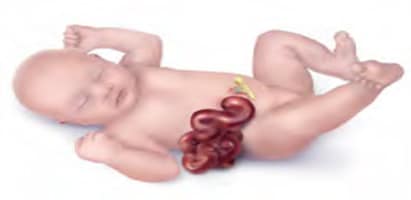
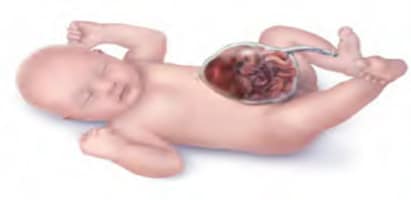
Responses:
- Gastroschisis Q79.3; omphalocele: Q79.2
- In gastroschisis, the abdominal opening is positioned lateral to the umbilical cord insertion, usually to the right.
- In omphalocele, the abdominal contents are herniated through an enlarged umbilical ring and the umbilical cord is inserted in the distal part of the membrane covering the defect. It is important to note that omphalocele and gastroschisis may not be easily differentiated when the membrane covering the omphalocele has ruptured.
Have them explain their responses aloud as a group.

Responses:
- Omphalocele can be seen in the photograph, but the membrane is ruptured.
Hydrocephalus cannot be seen in all the photos; therefore, use a code for spina bifida either with or without hydrocephalus. After enough time has been given to complete the activity, discuss responses aloud as a larger group.
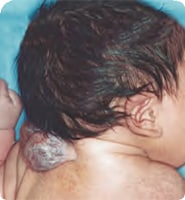
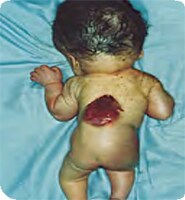
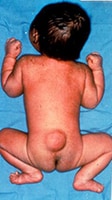
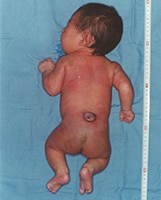
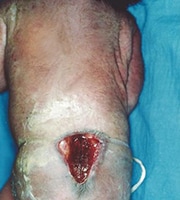
Responses:
- Photo A: Cervical spina bifida with or without hydrocephalus – Q05.0 or Q05.5
- Photo B: Thoracic spina bifida with or without hydrocephalus – Q05.1 or Q05.6
- Photo C: Lumbar spina bifida with or without hydrocephalus – Q05.2 or Q05.7
- Photo D: Lumbar spina bifida with or without hydrocephalus – Q05.2 or Q05.7
- Photo E: Lumbar spina bifida with or without hydrocephalus – Q05.2 or Q05.7
| Q05.0 | Cervical spina bifida with hydrocephalus |
| Q05.1 | Thoracic spina bifida with hydrocephalus |
| Q05.2 | Lumbar spina bifida with hydrocephalus; Lumbosacral spina bifida with hydrocephalus |
| Q05.3 | Sacral spina bifida with hydrocephalus |
| Q05.4 | Unspecified spina bifida with hydrocephalus |
| Q05.5 | Cervical spina bifida without hydrocephalus |
| Q05.6 | Thoracic spina bifida without hydrocephalus |
| Q05.7 | Lumbar spina bifida without hydrocephalus; Lumbosacral spina bifida without hydrocephalus, not otherwise specified |
| Q05.8 | Sacral spina bifida without hydrocephalus |
| Q05.9 | Spina bifida, unspecified |
- World Health Organization. Congenital anomalies. Fact sheet No 370. October 2012 (http://www.who.int/mediacentre/factsheets/fs370/en/index.htmlexternal icon, accessed 29 April 2015).
- Resolution WHA63.17. Birth defects. In: Sixty-third World Health Assembly, Geneva,17–21 May 2010. Geneva: World Health Organization; 2010 (http://apps.who.int/gb/ebwha/pdf_files/WHA63/A63_R17-en.pdfpdf iconexternal icon, accessed 29 April 2015).
- International statistical classification of diseases and related health problems, 10th revision. Geneva: World Health organization; 2015 (http://apps.who.int/classifications/icd10/browse/2015/enexternal icon, accessed 24 February 2015).
- World Health Organization, National Center on Birth Defects and Developmental Disabilities from the United States Centers for Disease Control and Prevention (CDC), International Clearinghouse for Birth Defects Surveillance and Research (ICBDSR). Birth defects surveillance: a manual for programme managers. Geneva: World Health Organization; 2014 (https://www.cdc.gov/ncbddd/birthdefectscount/documents/bd-surveillance-manual.pdfpdf icon, accessed 10 February 2015).
- World Health Organization, National Center on Birth Defects and Developmental Disabilities from the United States Centers for Disease Control and Prevention(CDC), International Clearinghouse for Birth Defects Surveillance and Research (ICBDSR). Birth defects surveillance: atlas of selected congenital anomalies. Geneva: World Health Organization; 2014 (http://apps.who.int/iris/bitstream/10665/127941/1/9789241564762_eng.pdf?ua=1pdf iconexternal icon, accessed 10 February 2015).
- CDC Foundation. What is public health? (http://www.cdcfoundation.org/content/what-public-healthexternal icon, accessed 24 February 2015).